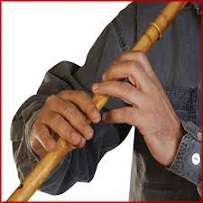Looking for Turkish kavals? Want to know about all the different types of kavals available? Read our guide for more information on choosing the right kaval for you…
Turkish kavals are a wind blown musical instrument that resembles a flute. Associated with mountain shepherds, the kaval spread throughout Eastern Europe and Greece from the Yoruk tribe of people who inhabit the Taurus mountains of Southern Turkey. Kavals are known by different names in various countries.
Turkish kavals are open at both ends and have eight holes. A player would blow the kaval at one end of the flute through the mouth piece. There are four smaller holes towards the end of the kaval known as devil’s holes. These improve both the intonation and the tone of the notes that emanate from the kaval. Metal kavals are known as ‘madeni kaval’.
Turkish kavals are frequently made from wood such as mountain ash, apricot and cornel cherry. Modern kavals are also made from plastic and metal. Water buffalo horn is also a suitable material for making fine kavals. Reed kavals are known as ‘kamis kaval’ and pine kavals are ‘cam kaval’. The ‘cura kaval’ is a small kaval.
When played, Turkish kavals are held to the mouth with both hands at an angle of about 45 degrees to the body. Four fingers of one hand cover the lower holes and the upper holes are covered by the other hand. The notes made by a kaval are melancholic, warm and pleasant.
Once a traditional shepherd’s musical instrument, Turkish kavals have found their way into mainstream folk music. Kavals are played during musical ensembles and as a solo accompaniment to dances. They are also sometimes played rhythmically in pairs.
Kavals Of Various Countries
Turkish kavals are similar to Arab neys. This wooden flute is predominant in south-eastern Europe where it traveled from Turkey. Bulgarian kavals have evolved from the single instrument to three separate sections with a total length of up to 90cm. These kavals exceed the Turkish kavals in range, covering almost three octaves. A Turkish kaval plays only two octaves. In Albania the kaval is known as a fyell. In Kosovo, the kaval is played in pairs. In Greece, the kaval is known as souravli.
Turkish kavals remain to this day as melodious flute instruments which dominate the folk music scene of Turkey. Although originally played by Yoruk shepherds in the mountains of Taurus in south Turkey, kavals have spread across southern Europe to develop into the folk instruments of several countries including Greece and Bulgaria. Made primarily from wood, kavals exude music that is much admired even today.





